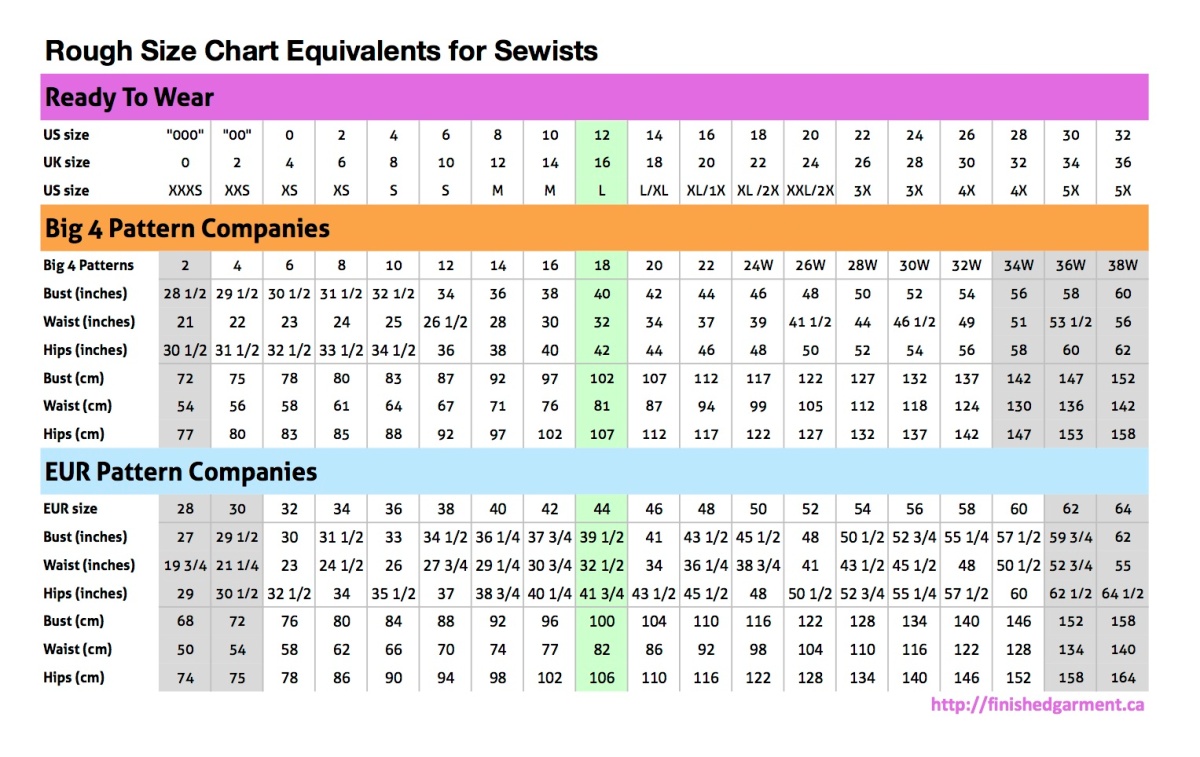While I was writing up my list of Independent Sewing Patterns for the Plus-Sized Sewist, one of the things I noticed was how different everyone’s sizing system was. And the larger the pattern sizes available, the more the systems varied from pattern maker to pattern maker.
I looked online for some sort of chart that would link up all the sizing systems. There were some good ones. The Named Patterns size chart includes lots of sizing systems, but it only goes up to size EUR 46. There is also a cute online clothing size conversion tool, but it doesn’t include measurements or pattern sizes. And there is a fabulous list by Cashmerette, that compares the sizing systems of some of the most popular independent pattern makers.
But overall, there wasn’t what I needed, especially not in the plus size range, so I made my own.
This is a rough guide to how clothing sizes and sewing pattern sizes match up across the most commonly used clothing systems. Please click to enlarge. For more details, please read the notes below.

Download the Rough Size Chart Equivalents for Sewists as a PDF (450 kb)
How This Chart Was Built
Where does this information come from?
I used the combined available size charts from major pattern manufacturers, clothing manufacturers and international size standards. I didn’t include independent pattern company size charts, which vary a great deal. And for some indie pattern companies, that is part of their marketing and their charm. Pear shaped? extra curvy? petite? Some indie pattern companies are intentionally catering to that demographic and their size charts reflect that.
Should I choose my pattern size based on this chart?
Probably not. It’s always a good idea to read the measurements that come with a specific pattern for a better fit.
Why are some sizes greyed out?
The greyed out sizes are purely fictitious. They don’t exist on the size charts of major manufacturers. But since human beings do come in those sizes, I extended out the available sizes myself, using the same approximate measurement intervals. I made educated guesses. I know that is not exactly how sizing or pattern grading works, but since these sizes are not actually available, I figure my approximations are better than nothing. Since some of the larger “official” sizes are rarely, if ever available, my approximations are about as useful.
Why did you only include EUR sizes 28-64?
I stopped at size EUR 64. Again, human beings come in larger sizes, so the size chart could easily be expanded (and should be!). However, this includes all the sizes that I could find in my list of Independent Sewing Patterns for the Plus-Sized Sewist. I also found it extremely difficult to find consensus among clothing manufacturers about what exactly constitutes the 6X to 10X+ size range.
What’s the green bar?
The average bust size in the USA in 2004, according to Size USA was 40″. The green bar, therefore, is the average size of women in the USA. I found it very interesting that for many independent pattern companies, this was the largest size they made. Even Big 4 pattern companies often stop at size 18, and sometimes 16, for individual patterns.
What’s going on with sizes XL, 1X and 2X?
In theory, XL and 1X should be equivalent and XXL and 2X should be equivalent, but those sizes are very approximate, and vary greatly among clothing manufacturers.
Is the sizing for 1x to 5x accurate?
Maybe. There doesn’t seem to be a clear standard for those clothing sizes, at least not one that I could find. However, this chart best approximates the reported sizing used by significant number of large clothing manufacturers and distributors. It’s also quite close to the KwikSew size chart for sizes 1X to 4X. I wanted to include that information as well, but I couldn’t see any easy way to incorporate those sizes and still keep the chart tidy and legible.
Do you have suggestions? complaints?
I hope you find the chart useful. If you have any comments or would like to suggest improvements, I’d love to hear about it! Please leave your thoughts in the comments.


Thanks Shannon! That is interesting.
LikeLike
Very helpful! If people are interested in a comprehensive table of independent pattern sizes (and comparison to the big4), I have that here: http://cashmerette.blogspot.co.uk/2014/03/one-stop-guide-to-sewing-pattern-sizes.html
LikeLike
Your comparison table is awesome! Thank you for sharing.
LikeLike
What are the RTW sizes based on (ie who’s the source)? I thought RTW sizes are highly unreliable as retailers / manufacturers all do vanity sizing nowadays and frequently use different fit models depending on their target audience. So that there is no reliable standards in RTW sizing anymore.
I guess what I’m trying to say is would it not be better for sewers to just forget RTW sizing and start with their own key measurements?
LikeLike
Standard US clothing sizes can be found here. These sizes were developed by statisticians, using a federal grant and as a project for the the US National Bureau of Standards. Their team measured almost 15,000 women across the US in order to develop this sizing system. Later studies have confirmed that this sample was, at the time, representative of the population. Standard EU clothing sizes can be found here. They were developed by the European standards committee and became the de facto standard in the EU in 2007.
This chart is a rough sizing comparison guide. Many new sewists find it useful to see an approximate RTW size, in a comparison chart. I’m not a new sewist, and I find it useful. Which is why I built the chart and am now sharing it.
LikeLike